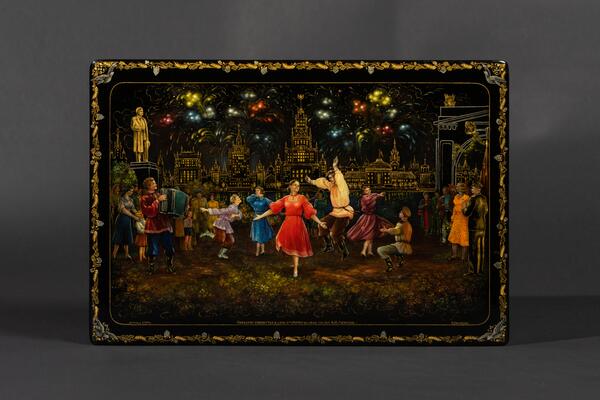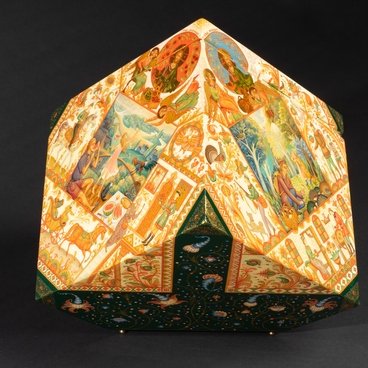Artist Igor Balakin was born in 1919 in Barnaul. He finished seven grades and then moved to his mother’s homeland in the Vladimir region. There he studied the art of lacquer miniatures under the founders of the Mstyora school — Alexander Kotyagin, Ivan Fomichev, Vasily Ovchinnikov, Alexander Bryagin and others. From 1939 to 1968, the artist worked in the artel ‘Proletarian Art’. Over the years, he painted more than 200 miniatures and developed a unique painting style. The master always paid special attention to contemporary topics: he often reflected in his paintings the life and work of the Soviet people.
Even during his studies at the Mstyora Professional Artistic School, Igor Balakin stood out among his classmates due to his drawing skills: he was able to quickly grasp all the most fundamental features of a model in such a way that the painted image had an uncanny resemblance to it; in the first years of his career, he was already known as the ‘king of the portrait’. Simultaneously, the artist developed his own unique manner — the so-called ‘Balakin style’ of painting. It was distinguished by beautifully constructed compositions. Thanks to Igor Balakin’s talent and skillful mastery of subtle miniature painting techniques, he was often commissioned by the state, and regularly participated in domestic and foreign exhibitions.
Gradually, the master moved from symbolic imagery, traditional for lacquer painting, to depictions of the Soviet reality in the Socialist Realism style: the purpose of this method was to glorify the achievements of the state by producing idealized images of the life of workers.
On the box “People”s festivities on the opening day of the Lenin Canal”, the master painted a multi-figure composition, in the center of which one can see smartly dressed young men and women dancing. Fireworks sparkle with multicolored flashes above the architectural complex in the background. The miniature reflected the atmosphere of general exultation on the day of the official opening of the Lenin Volga–Don Canal on July 27, 1952.
The Lenin Volga-Don Shipping Canal connected two great rivers. The waters of the Volga and Don Rivers met on May 31, 1952 at 14:55. It was a grandiose event: due to the construction of the canal, the city of Stalingrad (presently — Volgograd) became a port of five seas: the White, Baltic, Azov, Black and Caspian Seas. There are 13 locks, 3 reservoirs, and a network of irrigation channels on the 101-kilometer-long canal.
Even during his studies at the Mstyora Professional Artistic School, Igor Balakin stood out among his classmates due to his drawing skills: he was able to quickly grasp all the most fundamental features of a model in such a way that the painted image had an uncanny resemblance to it; in the first years of his career, he was already known as the ‘king of the portrait’. Simultaneously, the artist developed his own unique manner — the so-called ‘Balakin style’ of painting. It was distinguished by beautifully constructed compositions. Thanks to Igor Balakin’s talent and skillful mastery of subtle miniature painting techniques, he was often commissioned by the state, and regularly participated in domestic and foreign exhibitions.
Gradually, the master moved from symbolic imagery, traditional for lacquer painting, to depictions of the Soviet reality in the Socialist Realism style: the purpose of this method was to glorify the achievements of the state by producing idealized images of the life of workers.
On the box “People”s festivities on the opening day of the Lenin Canal”, the master painted a multi-figure composition, in the center of which one can see smartly dressed young men and women dancing. Fireworks sparkle with multicolored flashes above the architectural complex in the background. The miniature reflected the atmosphere of general exultation on the day of the official opening of the Lenin Volga–Don Canal on July 27, 1952.
The Lenin Volga-Don Shipping Canal connected two great rivers. The waters of the Volga and Don Rivers met on May 31, 1952 at 14:55. It was a grandiose event: due to the construction of the canal, the city of Stalingrad (presently — Volgograd) became a port of five seas: the White, Baltic, Azov, Black and Caspian Seas. There are 13 locks, 3 reservoirs, and a network of irrigation channels on the 101-kilometer-long canal.



